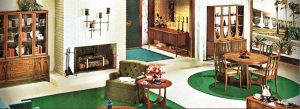 Pricing Your Services – What NOT to Do
Pricing Your Services – What NOT to Do
by Marina Darlow
Pricing your services is tricky. It has to be rooted in market research, it touches on your branding, it ties into issues of self-worth, and we just began to scratch the surface. There is a whole host of factors you’re supposed to take into account.
There is an abundance of pricing advice online. Some of it’s great, some… let’s not even go there. Recently I witnessed a text-book example of What NOT To Do. It’s so stark and clear, I had to share it.
This is a quirky but true story!
We have recently moved to a new house and the excitement is still in the air. I’m neck-deep in decorating fantasies, and even deeper in Craigslist. Mid-century furniture junky that I am, hours of trolling the furniture section is my idea of unwinding.
A few days ago I stumbled upon a beautiful dining room, listed for a couple hundred dollars. Not uncommon, provided we’re talking run-of-the-mill furniture bought at, say, Target a few years back. The set in question was, however, one of the most sought-after mid-century icons – a Broyhill Brasilia dining room, normally sold for four figures even on used furniture websites. (That’s what in the picture above. You’re welcome). Dedicated fans daydream about a Brasilia piece and go to great lengths to own it; some are willing to spend tons of cash, others hours of grueling restoration work.
I emailed the seller, and brought the info above to his attention. The guy thanked me profusely, and happily told me he’d raise the price. Feeling I’ve done my act of random kindness for the day, I was curious to see the new ad.
The dining room was now listed for over a thousand dollars.
But!
The seller didn’t change a single word in the ad. No mention of the iconic Broyhill Brasilia name, which would have brought him a ton of inquiries. Not a word about the fact that it’s a mid-century classic. Or even a mid-century furniture at all. No indication of the condition of the piece.
It was an average ad for plain old furniture, priced three times higher for no apparent reason.
People looking for a used dining room, would be turned away by the price. Mid-century lovers, willing to pay, wouldn’t even find it – they’d be looking for specific keywords like “mid-century” or “Brasilia”, the seller neglected to include.
Who’d buy it now?
At least the old ad could attract a generic buyer.
We’ve been repeatedly told to charge what we’re worth. This is a great piece of advice, with one significant caveat that is often overlooked. If you have something valuable to offer, let the audience know what it is. Say, an iconic piece of history, I mean furniture. Why is it special? Maybe because your unique offering is hard to find, or extra gorgeous, or will serve the client for ages, or all of the above.Who would appreciate it (for the sake of the example let’s stick with mid-century design lovers, collectors, furniture junkies like yours truly).
Explain Why Your Service or Product is Special
Otherwise you’re selling an old dining room set, in an unknown condition, for a three times the price.
Marina Darlow is a Business Systems’ expert, and a productivity geek.
She sees her job as helping impact-driven entrepreneurs get 10-20 more productive hours a week , stop leaking money, and prevent stress-fueled breakdowns.
An engineer by training, Marina came to a realization a couple years ago: working for a conglomerate is not as inspiring as she wants her life work to be. The quest for inspiration brought her to found Vision Framework, a company that builds small, purpose-driven businesses from the inside, helping entrepreneurs run their companies with ease by putting effective, easy-to-use, and fun (yep!) systems in place.


